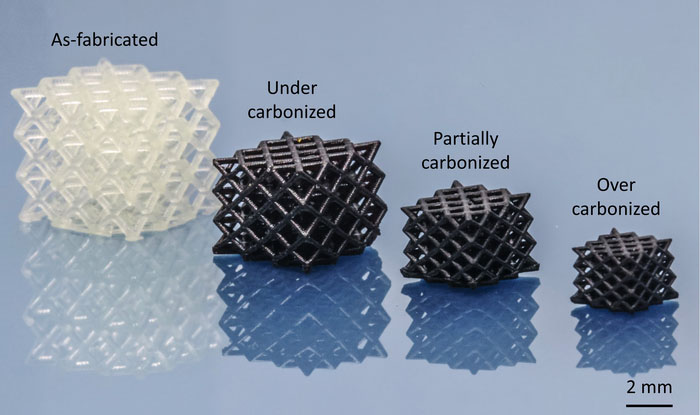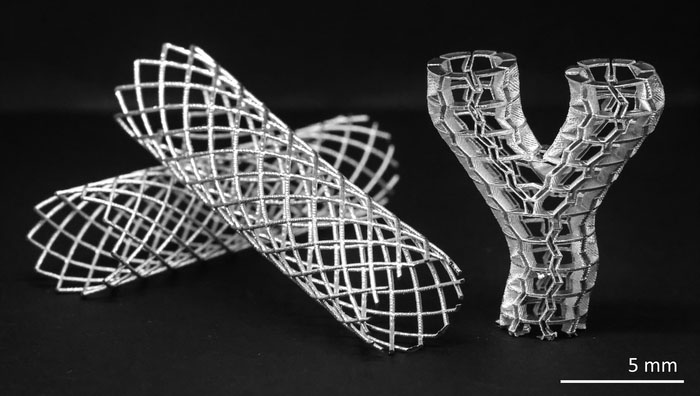| Sep 07, 2022 |
New method converts 3D-printed polymer into a 100-times stronger, ductile hybrid carbon microlattice material
|
|
(Nanowerk News) Developing a lightweight material that is both strong and highly ductile has been regarded as a long-desired goal in the field of structural materials, but these properties are generally mutually exclusive.
|
|
Researchers at City University of Hong Kong (CityU) recently discovered a low-cost, direct method to turn commonly used 3D printable polymers into lightweight, ultra-tough, biocompatible hybrid carbon microlattices, which can be in any shape or size, and are 100 times stronger than the original polymers.
|
|
The research team believes that this innovative approach can be used to create sophisticated 3D parts with tailored mechanical properties for a wide range of applications, including coronary stents and bio-implants.
|
 |
| The four main types of samples studied in this work, namely as-fabricated, under-carbonized, partially carbonized, and over-carbonized microlattices. (Image: Surjadi, James et al.)
|
|
Metamaterials are materials engineered to have properties that are not found in naturally occurring materials. 3D architected metamaterials, such as microlattices, combine the benefits of lightweight structural design principles with the intrinsic properties of their constituent materials.
|
|
Making these microlattices often requires advanced fabrication technologies, such as additive manufacturing (commonly referred to as 3D printing), but the range of materials available for 3D printing is still fairly limited.
|
|
“3D printing is becoming a ubiquitous technology for producing geometrically complex components with unique and tuneable properties. Strong and tough architected components usually require metals or alloys to be 3D printed, but they are not easily accessible owing to the high cost and low resolution of commercial metal 3D printers and raw materials. Polymers are more accessible but typically lack mechanical strength or toughness. We found a way to convert these weaker and brittle 3D-printed photopolymers into ultra-tough 3D architectures comparable to metals and alloys just by heating them under the right conditions, which is surprising,” said Professor Lu Yang in the Department of Mechanical Engineering (MNE) and Department of Materials Science and Engineering (MSE) at CityU, who led the research.
|
A new method to increase strength without compromising ductility
|
|
So far, the most effective approach for increasing the strength of these 3D printable polymer lattices is pyrolysis, a thermal treatment that transforms the entire polymers into ultra-strong carbon. However, this process deprives the original polymer lattice of almost all its deformability and produces an extremely brittle material, like glass. Other methods to increase the strength of the polymers also typically result in compromising their ductility.
|
|
The team led by Professor Lu found a “magic-like” condition in the pyrolysis of the 3D-printed photopolymer microlattices, which resulted in a 100-fold increase in strength and doubled the ductility of the original material. Their findings were published in the scientific journal Matter ("Lightweight, Ultra-tough 3D Architected Hybrid Carbon Microlattices").
|
|
They discovered that by carefully controlling the heating rate, temperature, duration and gas environment, it is possible to simultaneously enhance the stiffness, strength and ductility of a 3D-printed polymer microlattice drastically in a single step.
|
 |
| Demo of coronary stents with the 3D-printed partially carbonized core. (Image: Surjadi, James et al.)
|
|
Through various characterization techniques, the team found that simultaneous improvement in strength and ductility is possible only when the polymeric chains are “partially carbonized” by slow heating, where incomplete conversion of the polymer chains to pyrolytic carbon occurs, producing a hybrid material in which both loosely cross-linked polymer chains and carbon fragments synergistically coexist. The carbon fragments serve as reinforcing agents that strengthen the material, while the polymer chains restrict the fracture of the composite.
|
|
The ratio of polymer to carbon fragments is also crucial to obtaining optimal strength and ductility. If there are too many carbon fragments, the material becomes brittle, and if there are too few, the material lacks strength. During the experiments, the team successfully created an optimally carbonized polymer lattice that was over 100 times stronger and over two times more ductile than the original polymer lattice.
|
Benefits beyond mechanical property enhancement
|
|
The research team also found that these “hybrid carbon” microlattices showed improved biocompatibility compared to the original polymer. Through cytotoxicity and cell behaviour monitoring experiments, they proved that the cells cultured on the hybrid carbon microlattices were more viable than cells seeded on the polymer microlattices. The enhanced biocompatibility of the hybrid-carbon lattices implies that the benefits of partial carbonization may go beyond enhancement in mechanical performance and potentially improve other functionalities as well.
|
|
“Our work provides a low-cost, simple and scalable route for making lightweight, strong and ductile mechanical metamaterials with virtually any geometry,” said Professor Lu.
|
|
He envisions that the newly invented approach can be applied to other types of functional polymers, and that the geometrical flexibility of these architected hybrid-carbon metamaterials will allow their mechanical properties to be tailored for a wide range of applications, such as biomedical implants, mechanically robust scaffolds for micro-robots, energy harvesting and storage devices.
|


